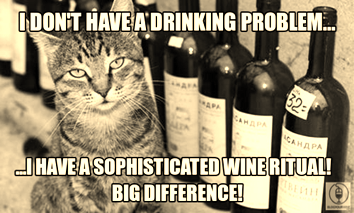Beware of the Dreaded Wine Meme!!!
August 14, 2012
For those of you who aren’t “down with the kids,” a meme (according to Wikipedia) is:
“an idea, behavior or style that spreads from person to person within a culture.”
In a nutshell, a meme [pronounced “meem”] is most commonly seen on social networks in the form of a photo with a funny tagline attached (as shown to the left).
Paul Mabray (of Vintank fame) posted an article a few days ago which really struck a chord with me, mainly because I’ve been thinking about the role of memes in marketing a lot recently.
The article reads:
“For the wine industry we believe that Facebook is the place to engage with your TRUE FANS. These are the people that truly want to have a relationship with your winery. This also means giving them meaningful content that relates to your winery/brand. Unfortunately one of the biggest trends in Facebook marketing is using wine meme’s to raise up the engagement with your fans.
You are not really getting true engagement or brand building with your fan base [with memes]. You are just telling a funny joke that people like to laugh at (the digital equivalent is a “Like”). Just like a joke, it is great to share but has nothing to do with the brand (aka joke teller) but with the joke itself. You are slowly shifting from your brand essence to “the funny kid in the class.”
Consumers belonging to many wine Fan Pages see these repeat themes and view your brand as lazy or copycat.
So how do you avoid the pitfall of the “wine meme?” Create original content. One of our favorite wine meme’s was from Winefolly.com. They made it creative commons and branded it on the bottom as their own so when it was shared, it was quoted from them.
Click here for the full article from Vintank
My Thoughts…
The facts of the matter are this:
– The idea of social networks (at least from a winery perspective), is to get as many eyeballs on your brand as possible and “ENGAGE” with consumers, or at least potential consumers.
– Memes get likes….lots of likes.
– Likes increase the Facebook “Edgerank” of a Page.
– Edgerank is what determines how many people will see your posts in their newsfeed.
– If you’re not getting enough likes, your Edgerank drops, and not as many people will see the relevant content you post.
Links to Pages outside of Facebook and brand messages, on the whole, will always get fewer likes than memes. ALWAYS!
I’ve mentioned this before, but “likes” on Facebook or “+1s” on Google+ tell me that the reader didn’t really “fully-engage” with the brand. They just enjoyed the content, usually for a total of about 3-4 seconds, probably with them not even clicking into it. By definition, is that “true engagement”? No, however; that’s the way Facebook has decided to measure the popularity of a page, so who are we to argue?
The concept of using memes to promote brands, or in this case wineries, is still an extremely recent phenomena and no-one has figured out the best way to approach it….yet. As I mentioned in my comment on the Vintank article, using WineFolly.com as an example of what wineries SHOULD be doing is completely unrealistic. Talented graphic artists (such as Madeline Puckette with WineFolly) aren’t at the beck-and-call of most wineries. Sure the big boys can afford to keep them on salary; but for everyone else, they need to rely on what they can “borrow” from other online sources and manipulate accordingly with Photoshop.
My advice for ANY winery is to find a balance between the “fun stuff” and the relevant content. As always, the cream will rise to the top! The more resourceful and marketing-savvy wineries (which has nothing to do with budget) will experiment with ways to combine their brand message into the form of bite-size and visual content, and THAT in my opinion is the future of memes!
In other news, I found out today that “meme” is Turkish for “breast.” Now you know!
This entry was posted in News and tagged meme, Wine meme. Bookmark the permalink. ← Wine: What am I Paying for and What’s the Difference? – I Know Jax Champagne De Venoge Grand Vin des Princes, 1993. →









